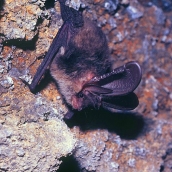Tenerife Long-eared Bat (Plecotus teneriffae)
Bat (forearm length of 40-46 mm; head and body length of 46-57 mm), distinguished by strikingly large ears, as in all species of the genus Plecotus. Dorsal fur is thick and dark brown-grey, while ventral fur is much paler. The tail is almost as long as the head-body length, the tip extending beyond the flight membrane. This species is considered endemic to the Canaries, but several recent studies have suggested that the long-eared bats of Northwest Africa and the Adriatic may be subspecies of P. teneriffae. Distribution encompasses Tenerife, La Palma and El Hierro, and there have been unconfirmed reports in La Gomera. It lives in a variety of habitats, over a broad range that extends from 150 m to 2,300 m, although most are found from 800-1,600 m altitude. It favours woodland, whether pine forests or transition zones from evergreen to fayal-brezal firetree and heath forests, although it also occupies potential areas of lowland Euphorbia communities, ravines at mid-altitude and high montane scrub. Its diet is mainly composed of nocturnal lepidoptera of the families Arctiidae, Geometridae, Lymantriidae and Noctuidae, and the occasional coleopteran. Prey is consumed inside diurnal and nocturnal shelters, namely volcanic caves, water tunnels, derelict buildings and bridges. Information on breeding habits is scant, but males are known to experience maximum testicular growth in September and females suckle their young in July and August; apparently pregnant females have also been sighted in May. Although displacements over a few kilometres between shelters have been confirmed, this bat’s movements are largely unknown and it appears to be mostly sedentary. The Tenerife long-eared bat is relatively common throughout the islands and is the most cave-dwelling bat of them all. However, it does face several threats, such as loss of habitat and human encroachment, hence its classification as Vulnerable.













